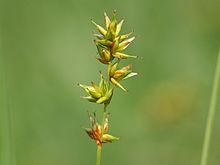Carex spicata
| Carex spicata | |
|---|---|

| |
| Scientific classification | |
| Kingdom: | Plantae |
| Clade: | Tracheophytes |
| Clade: | Angiosperms |
| Clade: | Monocots |
| Clade: | Commelinids |
| Order: | Poales |
| Family: | Cyperaceae |
| Genus: | Carex |
| Subgenus: | Carex subg. Vignea |
| Section: | Carex sect. Phaestoglochin |
| Species: | C. spicata
|
| Binomial name | |
| Carex spicata | |
| Synonyms | |
|
Carex contigua Hoppe | |
Carex spicata is a species of sedge in the genus Carex.
Description
[edit]
The culms of Carex spicata are 10–85 centimetres (4–33 in) long and approximately triangular in section.[1] The leaves are 7–45 cm (3–18 in) long and 2–4 millimetres (0.08–0.16 in) wide, with a distinct keel.[1] The ligule, at the base of the leaf, is 4–8 mm (0.16–0.31 in) long, with a large amount of loose white tissue.[1] C. spicata differs from the other species in Carex section Phaestoglochin by the presence of a purple pigment in the roots, leaf sheaths and bracts.[1]
The inflorescence is 4–8 cm (1.6–3.1 in) long, and comprises 3–8 spikes. Each spike is 5–10 mm (0.20–0.39 in) long, with female (pistillate) flowers at the base, and male (staminate) flowers at the tip.[1]
Distribution and ecology
[edit]Carex spicata has a European temperate distribution, although it has been extensively naturalised outside this native range.[2]
Carex spicata is usually found in grassland (usually in British NVC community MG10 in the British Isles), on roadsides, and in waste ground.[1] It is found on heavy, slightly base-rich soils, and cannot tolerate much competition.[2]
Taxonomy
[edit]Carex spicata was first described by the English botanist William Hudson in his 1762 work Flora Anglica.[3]
It is known in the British Isles as "spiked sedge",[1][4] in North America as "spicate sedge"[5] or "prickly sedge".[6] In Irish it is called cíb spícíneach,[7] and in Welsh, its name is hesgen dywysennog borffor,[8] hesgen dywysennog[9] or hesgen ysbigog borffor.[10]
Few hybrids have been reported between C. spicata and other members of Carex sect. Phaestoglochin, but hybrids have been reported between C. spicata and C. otrubae, and between C. spicata and C. echinata.[1]
References
[edit]- ^ a b c d e f g h A. C. Jermy; D. A. Simpson; M. J. Y. Foley; M. S. Porter (2007). "Carex muricata group (section Phaestoglochin Dumort.)". Sedges of the British Isles. BSBI Handbook No. 1 (3rd ed.). Botanical Society of the British Isles. pp. 220–242. ISBN 978-0-901158-35-2.
- ^ a b "Carex spicata (Spiked Sedge)". Online Atlas of the British & Irish Flora. Biological Records Centre. Retrieved July 7, 2011.
- ^ William Hudson (1762). "Carex". Flora Anglica (in Latin). Londini, impensis auctoris. pp. 346–354.
- ^ Clive A. Stace (2010). "Carex L. – sedges". New Flora of the British Isles (3rd ed.). Cambridge University Press. pp. 951–974. ISBN 978-0-521-70772-5.
- ^ Robert H. Mohlenbrock (2011). "Carex spicata". Sedges: Carex. The Illustrated Flora of Illinois (2nd ed.). Southern Illinois University Press. pp. 57–59. ISBN 978-0-8093-3024-9.
- ^ "Carex spicata Huds. prickly sedge". PLANTS Profile. United States Department of Agriculture. Retrieved July 7, 2011.
- ^ Wendy Guiry (October 16, 2008). "Carex spicata Huds". The Irish Species Register. Archived from the original on October 9, 2011. Retrieved July 7, 2011.
- ^ G. Battershall (2000). "Welsh Plant Records 1998" (PDF). Welsh Bulletin. 67. Botanical Society of the British Isles: 26–30. Archived from the original (PDF) on 2012-03-21.
- ^ "List of plant names" (PDF). National Botanic Garden of Wales . Archived from the original (PDF) on September 26, 2011. Retrieved July 7, 2011.
- ^ P. Jiménez-Mejías; M. Luceño (February 7, 2011). "Carex spicata Huds". Pan-European Species directories Infrastructure. Retrieved July 7, 2011.
External links
[edit]- Carex spicata Hudson, Fl. Angl. 349. 1762., Flora of North America
- Carex spicata Huds., University of Michigan Herbarium
- Carex spicata, "The Plants of Pennsylvania"
- Carex spicata, "The History of the British Flora"
 Media related to Carex spicata at Wikimedia Commons
Media related to Carex spicata at Wikimedia Commons
